Physical Address
304 North Cardinal St.
Dorchester Center, MA 02124
Hemangioma is the most common benign tumor of the liver, with a reported incidence ranging from 1% to 20% ( Table 53.1 ). ,
Hemangiomas occur primarily in women (female-to-male ratio of 5:1). Although hemangiomas may be present at all ages, they are seen more commonly in postmenopausal women. The worldwide prevalence of this tumor is fairly uniform. In a study of Vilgrain and colleagues, it was reported that there was a significant association between focal nodular hyperplasia (FNH) and hemangioma in the liver. Whereas each of these lesions is found commonly as an isolated hepatic mass, in 20% of patients in the study group of Vilgrain and colleagues, both lesions were present together.
Calcification is rare in this tumor; less than 10% of hemangiomas have calcification detectable by plain radiographs. Calcification can be either large and coarse (amorphous calcification within zones of fibrosis) or phlebolith-like thrombi within the vascular channels of hemangioma.
Radionuclide scintigraphy for identification of hemangiomas is not performed routinely in all centers, especially outside the United States. With tagged red blood cell (RBC) pool scans, there is a defect in the early phases that shows prolonged and persistent “filling in” on delayed scans. Many vascular tumors, such as hepatocellular carcinoma, adenoma, and FNH, may have persistent uptake, but all exhibit early uptake rather than a defect. Rarely, angiosarcomas can demonstrate the hemangioma pattern of early defect and late isotope uptake. In this context, new hybrid single photon emission computed tomography (SPECT)/CT systems may further aid diagnosis of hemangiomas by means of a more accurate anatomic localization of the lesions. In a study, SPECT/CT increased the accuracy of RBC scintigraphy in classifying the hepatic lesions as hemangiomas and nonhemangiomas from 70.8% to 87.5%.
On sonography, hemangiomas are typically hyperechoic and well demarcated and exhibit faint acoustic enhancement ( Fig. 53.1 ). The echogenicity may vary because these tumors may contain cystic and fibrotic regions. Color Doppler ultrasound demonstrates filling vessels in the periphery of the tumor, but no significant color Doppler flow deep within the hemangioma itself. Power Doppler, however, may detect minimal flow within hemangiomas, but the pattern is nonspecific and may be seen in hepatocellular carcinomas and metastases.
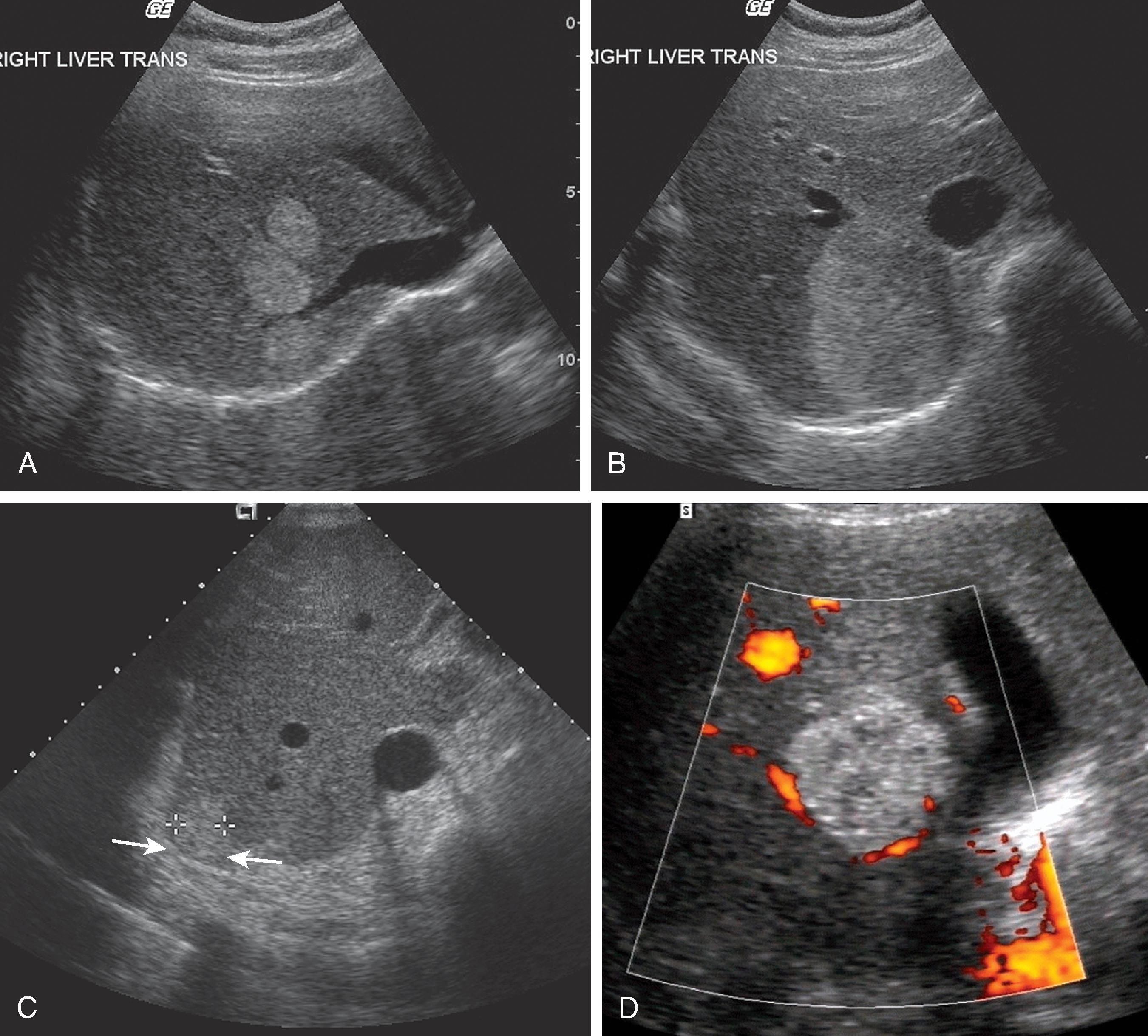
Hemangiomas, like other focal lesions of the liver, are detected and characterized with ultrasound not only by an analysis of echogenicity and vascularity but also by the changes occurring in inflow kinetics of ultrasound contrast agents. In general, ultrasound contrast agents consist of microbubbles of air or perfluorocarbon gas stabilized by a protein, lipid, or polymer shell. The small size (approximately the same as RBCs) and stability of the bubbles allow them to traverse the pulmonary and cardiac circulations after intravenous injection. The bubbles cannot move through the vascular endothelium into the interstitium and remain within the vessel until they disappear by the diffusion of the gas through their thin shell. Therefore, they are true blood pool agents and have a typical half-life of a few minutes in the circulation. Bubbles respond to sound emitted by the imaging transducer by oscillating and returning detectable echoes to the transducer.
On contrast-enhanced ultrasonography, hemangiomas demonstrate a typical specific peripheral nodular contrast enhancement and centripetal fill in. Whereas the “filling in” of the lesion can take several minutes with CT and iodinated contrast material, the kinetics of ultrasound contrast agents is different, and with them, the process can last even less than a minute. , Therefore, imaging in the first 60 seconds is critical in characterizing hemangiomas at ultrasound.
Hemangiomas appear as low-density masses with well-defined, lobulated borders on nonenhanced CT scans. Calcification is observed in 10% to 20% of cases. After intravenous administration of contrast material, both arterial phase and portal venous phase CT scans show early, peripheral, globular enhancement of the lesion. The attenuation of the peripheral nodules is equal to that of aorta. , In a study by Leslie and colleagues, the presence of globular enhancement isodense with the aorta was found to be 67% sensitive and 100% specific in differentiating hemangiomas from hepatic metastases. Therefore, if this pattern is visualized, no further evaluation is required. If venous phase CT is obtained, centripetal enhancement that progresses to uniform filling persists on delayed phase images ( Fig. 53.2 ). Although small lesions often fill in completely, large tumors may not show central nonenhancing zones during venous and delayed phases, corresponding to scar tissue or cystic cavities. On the other hand, approximately 16% of all hemangiomas and 42% of small ones (<1 cm in diameter) show immediate homogeneous enhancement at arterial phase CT imaging. This feature is relatively challenging for the differential diagnosis because other hypervascular tumors, including hepatocellular carcinoma, also may enhance rapidly during this phase of imaging. In such cases, accurate diagnosis can be made with delayed phase CT imaging because hemangiomas remain hyperattenuating, whereas hypervascular metastases do not. Another important and helpful imaging finding in diagnosis of this type of hemangiomas is that their attenuation is equal to that of the aorta during all phases of dynamic CT imaging. Hemangiomas may also be a cause of transient hepatic attenuation differences (THADs).
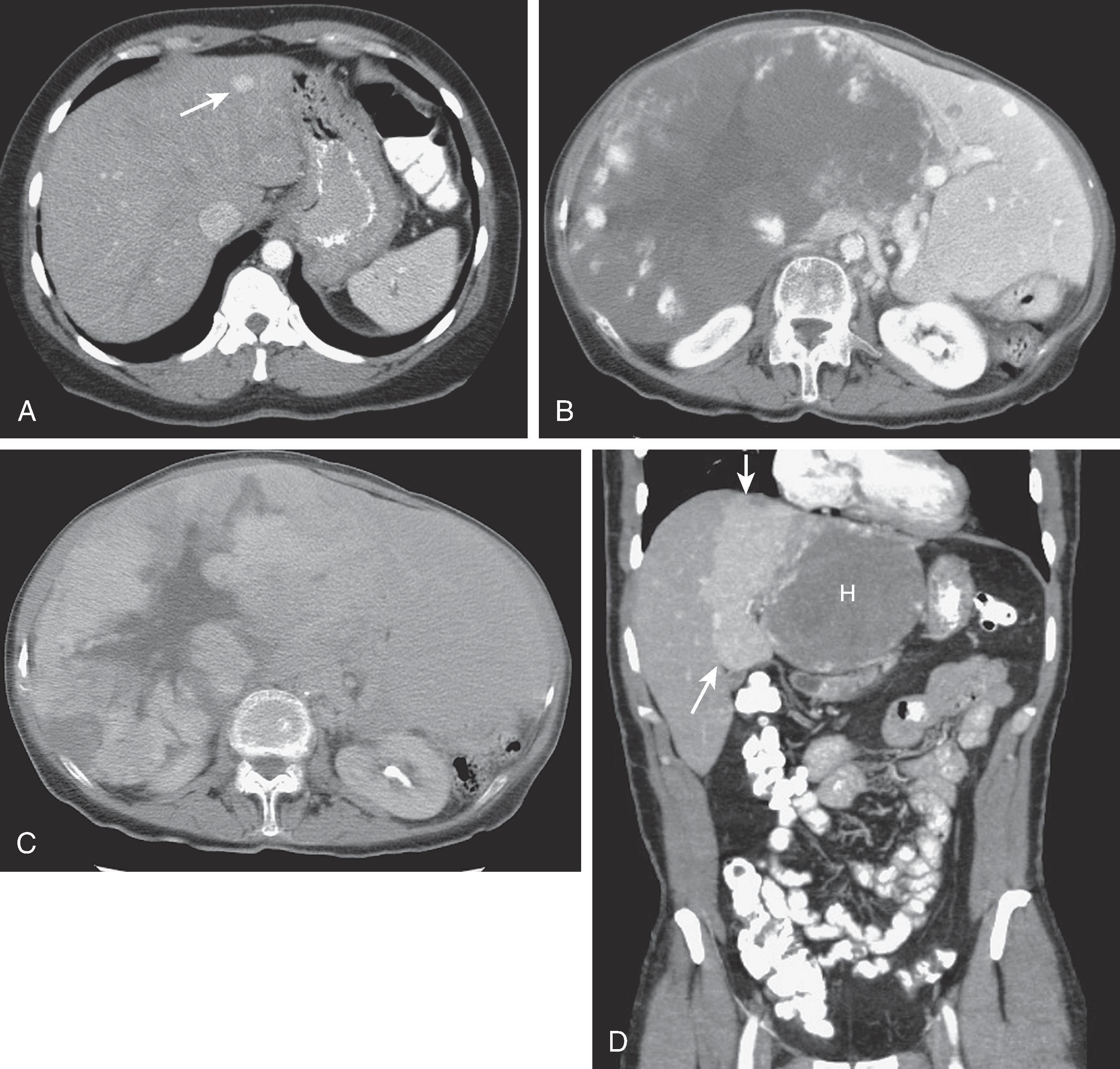
Although angiography is not routinely used in the diagnostic evaluation of hepatic hemangiomas, knowledge of the characteristic appearances is important because hemangiomas may coexist with metastases. In this scenario, correct identification of the lesions is vital because therapeutic options such as hepatic resection depend on the number and distribution of metastases. On angiography, there is pooling of contrast medium within the hemangioma, producing a characteristic “cotton wool” appearance, without evidence of arteriovenous shunting or tumor neovascularity. Hemangiomas typically retain contrast medium well beyond the venous phase.
The study of hemangiomas of the liver is one of the major applications of abdominal magnetic resonance imaging (MRI) ( Fig. 53.3 ). Hemangiomas generally have moderately low signal intensity on T1-weighted images and characteristically demonstrate marked hyperintensity on T2-weighted images, which may contain low-intensity areas correlating with zones of fibrosis. They maintain high signal intensity on longer echo time (>120 milliseconds) T2-weighted sequences. Nevertheless, the signal characteristics of other masses and neoplasms may overlap with those of hemangioma owing to their similar T2 values, and because of this overlap, characteristics at contrast-enhanced MRI are used for further evaluation. Suspected hemangiomas should be evaluated by a dynamic breath-hold sequence, in a manner similar to contrast-enhanced dynamic CT protocol. After intravenous administration of a contrast agent, a fast gradient-echo T1-weighted sequence (20–30 seconds) is repeatedly acquired once per minute until the lesion has filled in completely or nearly completely. In fact, three patterns of enhancement may be seen, depending on the size of the lesion. The majority of small (<1.5 cm) lesions show uniform early enhancement or peripheral nodular enhancement progressing centripetally to uniform enhancement. This second pattern is commonly seen in medium-sized lesions (1.5–5 cm) and in a few large (>5 cm) lesions. Most large hemangiomas exhibit peripheral nodular enhancement while the center of the lesion remains hypointense. Peripheral nodular enhancement is a useful discriminating feature in the differential diagnosis between hemangiomas and metastases. However, small lesions can be a diagnostic problem because a uniform pattern of enhancement is seen in both hemangiomas and vascular metastases. Flash-filling hemangiomas may also cause a serious problem regarding their differentiation from hypervascular metastases (e.g., those of malignant neuroendocrine tumors) because of a similar appearance in unenhanced and contrast-enhanced imaging. In the majority of cases, the combination of T2-weighted images and serial dynamic postgadolinium images allows a confident diagnosis of hemangioma to be made.
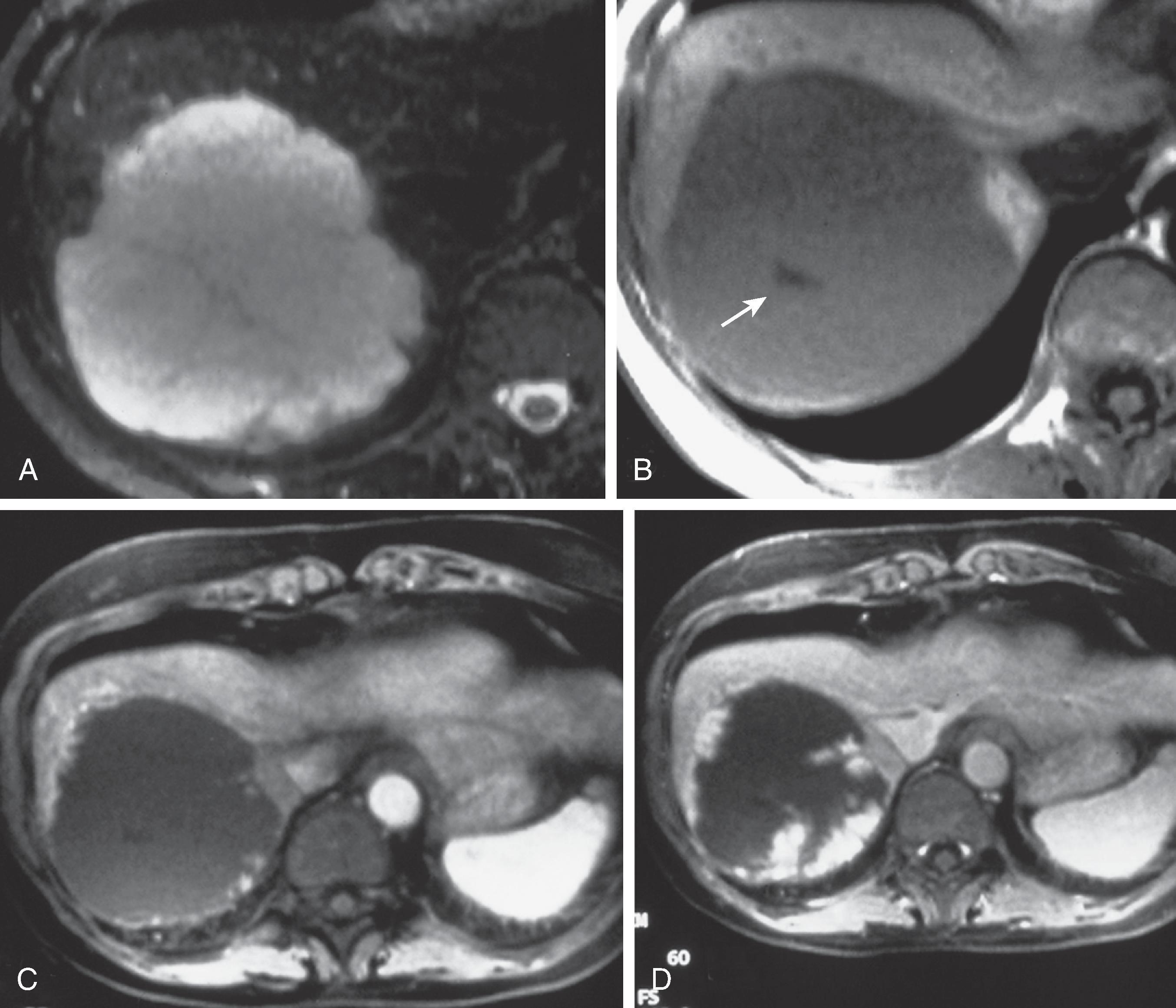
Hemangiomas appear isointense or hypointense in the late dynamic phase and hepatocyte phase with use of gadolinium ethoxybenzyl diethylenetriaminepentaacetic acid (Gd-EOB-DTPA). The reasons for this are marked hepatocyte uptake of Gd-EOB-DTPA in the surrounding liver, substantially low overall administered dose of Gd-EOB-DTPA, and substantially short plasma half-life of Gd-EOB-DTPA.
On diffusion-weighted imaging, hemangiomas show low signal intensity with increased b values and have high apparent diffusion coefficient (ADC) values like simple cysts ( Fig. 53.4 ). However, differentiation between cystic metastases and hemangioma or small flash-filling hemangiomas and hypervascular metastases cannot be achieved solely with this single-pulse sequence, and it should be interpreted in conjunction with contrast-enhanced images.
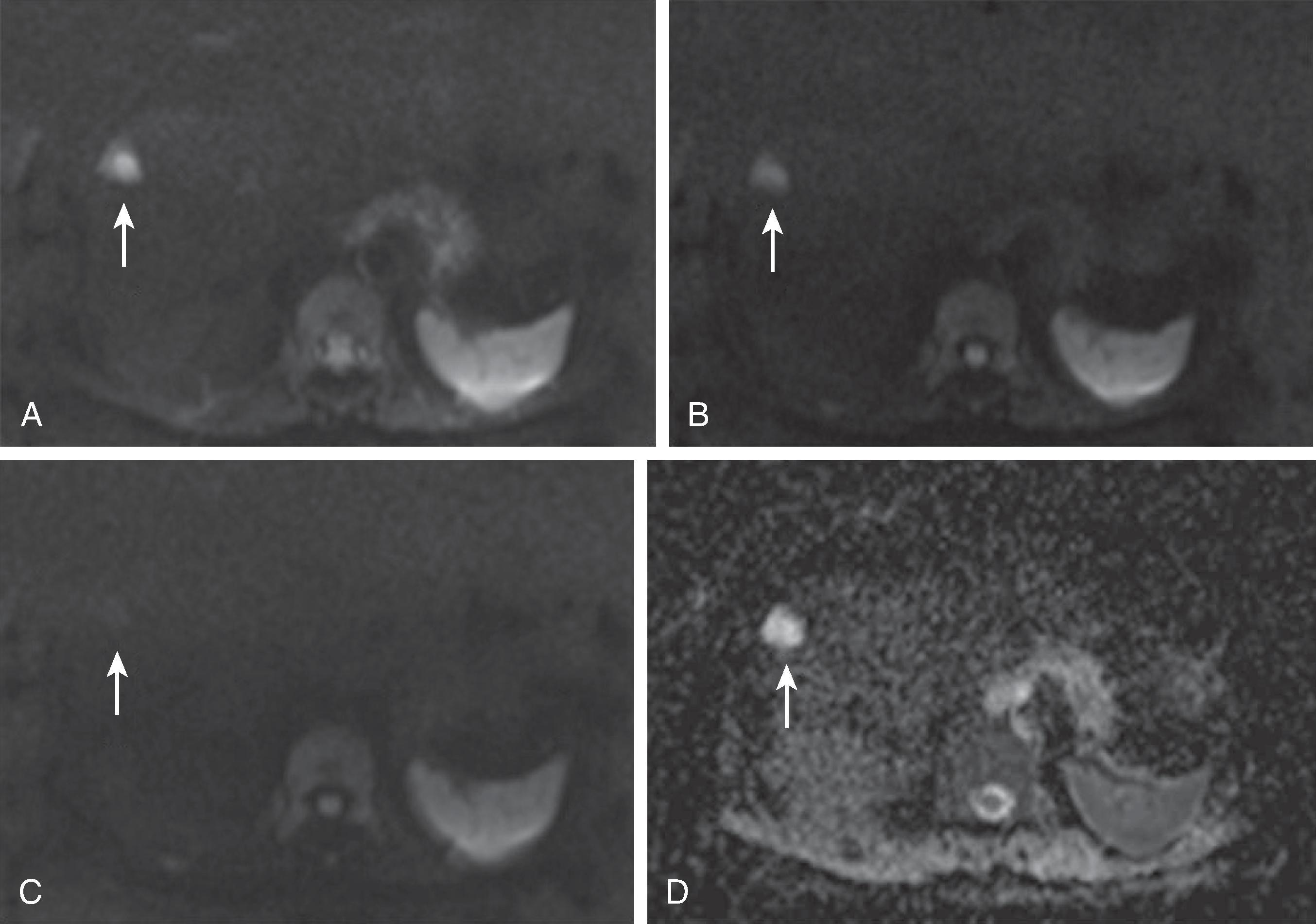
Differentiation of hepatic hemangiomas from other benign and malignant focal liver lesions is one of the most common problems in abdominal imaging. Most authorities believe that if a focal liver lesion has the classic appearance of a hemangioma on ultrasound, CT, or MRI examinations, it should be left alone. We believe that in patients with known malignant disease or abnormal liver function test results, one of the tests with high accuracy should be performed, such as multiphasic multidetector CT (MDCT) or gadolinium-enhanced dynamic MRI, for confirmation. In atypical cases, biopsy should be considered ( Table 53.1 ).
| Pathologic Features | Radiologic Features |
|---|---|
| Vascular channels | Echogenic mass: ultrasound |
| Blood-filled cavity | Hyperintense mass: T2-weighted image (MR) |
| No arteriovenous shunting | Early globular peripheral enhancement on contrast-enhanced helical CT, dynamic Gd-DTPA–enhanced T1-weighted MR and USPIO-enhanced T1-weighted MR |
| Delayed-persistent filling on red blood cell scan, enhanced conventional CT, Gd-DTPA–enhanced MR, angiography | |
| Fibrosis | Hypodense region: CT |
| Hypointense region: MR | |
| Hypoechoic region: ultrasound | |
| Calcification | Dense region: plain films, CT |
| Absent signal: MR | |
| Hyperechoic shadowing region: ultrasound |
Radiologic-pathologic correlates of this tumor are listed in Table 53.2 .
| Hyperplasia of normal liver | |
|---|---|
| Uptake of SPIO results in loss of signal | |
| Pathologic Features | Radiologic Features |
| Central scar with vessels and bile ducts | Hyperintense region: T2-weighted images (MR) |
| Spoke-wheel pattern: angiography | |
| Calcification rare | |
| Hyperplasia of normal liver (Kupffer cells, portal spaces, bile ductules) | Sulfur colloid uptake (80%) |
| Iminodiacetic acid uptake and excretion | |
| Homogeneous mass: CT, ultrasound, MR, angiography | |
| Hyperdense relative to live on arterial phase of contrast-enhanced helical CT, becoming isodense during portal venous phase of enhancement | |
| Uptake of SPIO results in loss of signal on T2-weighted MR | |
| Uptake of hepatobiliary contrast agents (e.g., mangafodipir, Gd-EOB-DTPA) results in hyperintensity relative to liver on T1-weighted images | |
FNH is the second most common benign hepatic tumor, constituting 8% of primary hepatic tumors in autopsy series. FNH is more common in women, predominating in the third to fifth decades of life. Oral contraceptives have a trophic effect on FNH, but there is debate as to whether these agents actually cause this tumor.
Clinically, FNH is usually an incidental finding at autopsy, elective surgery, or cross-sectional imaging. Fewer than one third of cases are discovered because of clinical symptoms, usually right upper quadrant or epigastric pain.
Plain radiograph calcification is almost never present. On occasion, a pedunculated FNH lesion may project to the margin of the liver and compress the adjacent stomach or hepatic flexure.
In the past, sulfur colloid scintigraphy was the preferred imaging technique in the diagnosis of FNH because of normal tracer uptake in approximately 50%, and a defect is seen in 40% of FNH cases. “Hot spots,” present in 10% of lesions, indicate an increased number of Kupffer cells. Hepatobiliary scans show tracer uptake in the majority of cases, and isotope excretion can be observed in 50% of delayed scans. Tagged RBC pool studies show early isotope uptake and late defect. There is no gallium uptake in FNH.
There are only a few studies about positron emission tomography (PET) imaging of FNH. In one study, it was reported that in contrast to liver metastases, there is no increased glucose metabolism in FNH in vivo. Also, the imaging features of FNH on 18 F-fluorodeoxyglucose (FDG) PET imaging are not specific.
Today, CT and MRI are used in the diagnostic workup of FNH. Nuclear medicine studies are reserved for exceptional circumstances.
On gray-scale ultrasound studies, FNH typically appears as a well-demarcated, hypoechoic mass that is homogeneous in tissue texture except for a central scar ( Fig. 53.5 ). Rarely (1.4%), calcifications may be seen within FNH, and the lesion may resemble fibrolamellar hepatocellular carcinoma. On color Doppler sonography ( Fig. 53.6 ), FNH shows increased blood flow, and a pattern of blood vessels radiating peripherally from a central feeding artery may be seen, similar to the findings at conventional angiography. In a contrast-enhanced examination, like hepatocellular carcinoma, FNH in the early arterial phase appears typically as a hyperperfused structure relative to the adjacent liver tissue. However, the specific morphologic features of these two entities are different. FNH typically enhances uniformly without the necrosis and heterogeneity often seen in hepatocellular carcinoma. The stellate lesion vascularity, a central nonenhancing scar, and a tortuous feeding artery are the other typical features of FNH. Nevertheless, portal venous phase imaging is critical for an accurate diagnosis to be reached. During this phase, as opposed to hepatocellular carcinoma, in which washout is generally seen, FNH remains isoechogenic with the portal vein and later with the liver parenchyma. ,
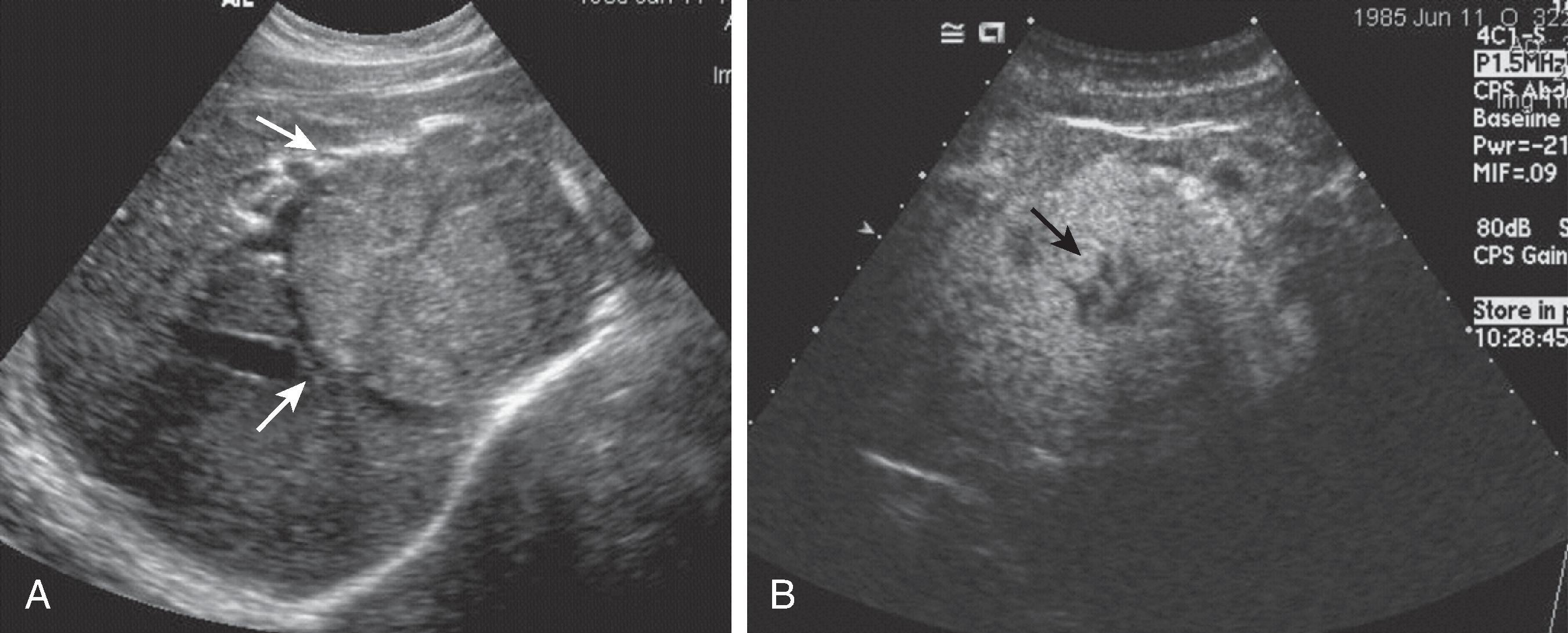
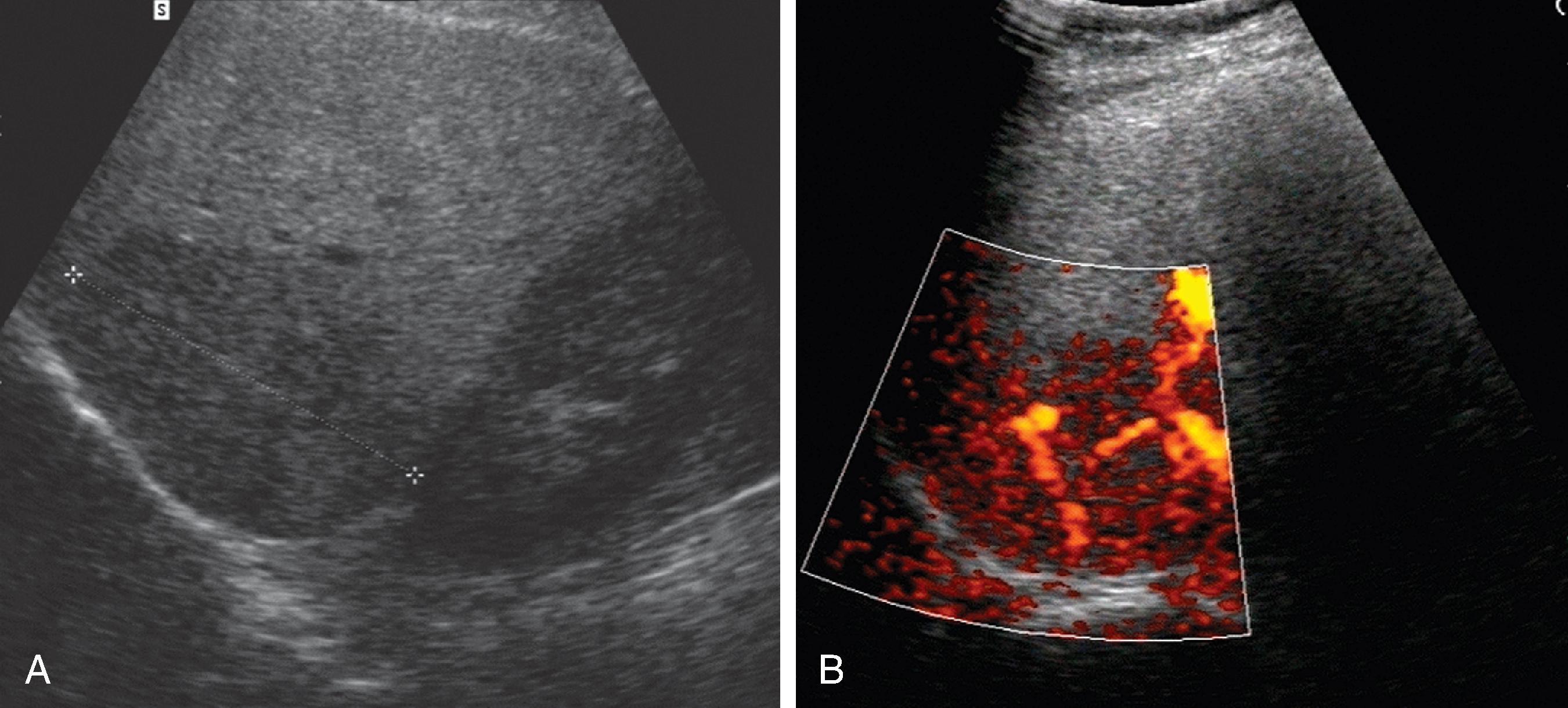
On nonenhanced scans, FNH usually appears as a homogeneous, hypodense mass ( Fig. 53.7 ). In a third of cases, a low-density central area is seen, corresponding to the scar. , During the arterial phase of contrast-enhanced CT, FNH enhances rapidly and becomes hyperdense relative to normal liver. The low-attenuation scar appears conspicuous against the hyperdense tissue, and foci of enhancement representing arteries may be seen within the scar. In the portal venous phase and later phases of enhancement, the difference in attenuation between FNH and normal liver decreases and the FNH may become isodense with normal liver. , Moreover, 10-minute delayed images can show increased uptake of contrast material in the scar relative to surrounding liver.
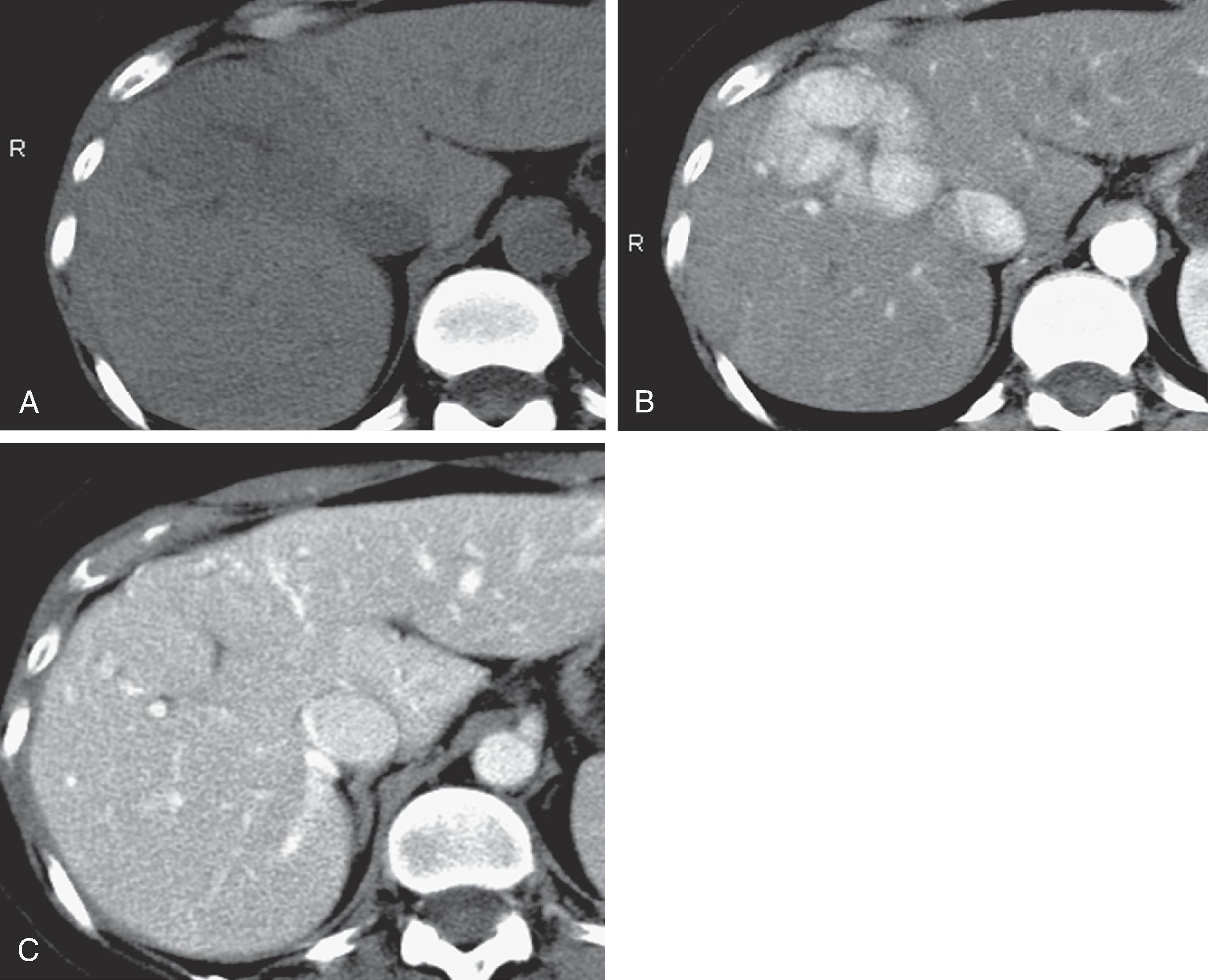
On angiography, FNH is a hypervascular tumor with a centrifugal blood supply creating a “spoke-wheel” pattern in 70% of cases. The scar is usually hypovascular. During the capillary phase, an intense and inhomogeneous stain without avascular zones is characteristic. During the venous phase, large veins draining the hypervascular FNH are noted. Angiography is no longer primarily used to diagnose FNH.
MRI has higher sensitivity (70%) and specificity (98%) for FNH than CT and ultrasound. On nonenhanced MRI studies, FNH is an isointense tumor on T1-weighted images that becomes slightly hyperintense to isointense on T2-weighted images ( Figs. 53.8 and 53.9 ). The central scar is hypointense on T1-weighted images and hyperintense on T2-weighted images. However, there is overlap in the appearance of FNH and malignant lesions on nonenhanced T1-weighted and T2-weighted images, and further characterization with contrast-enhanced dynamic studies may be necessary.
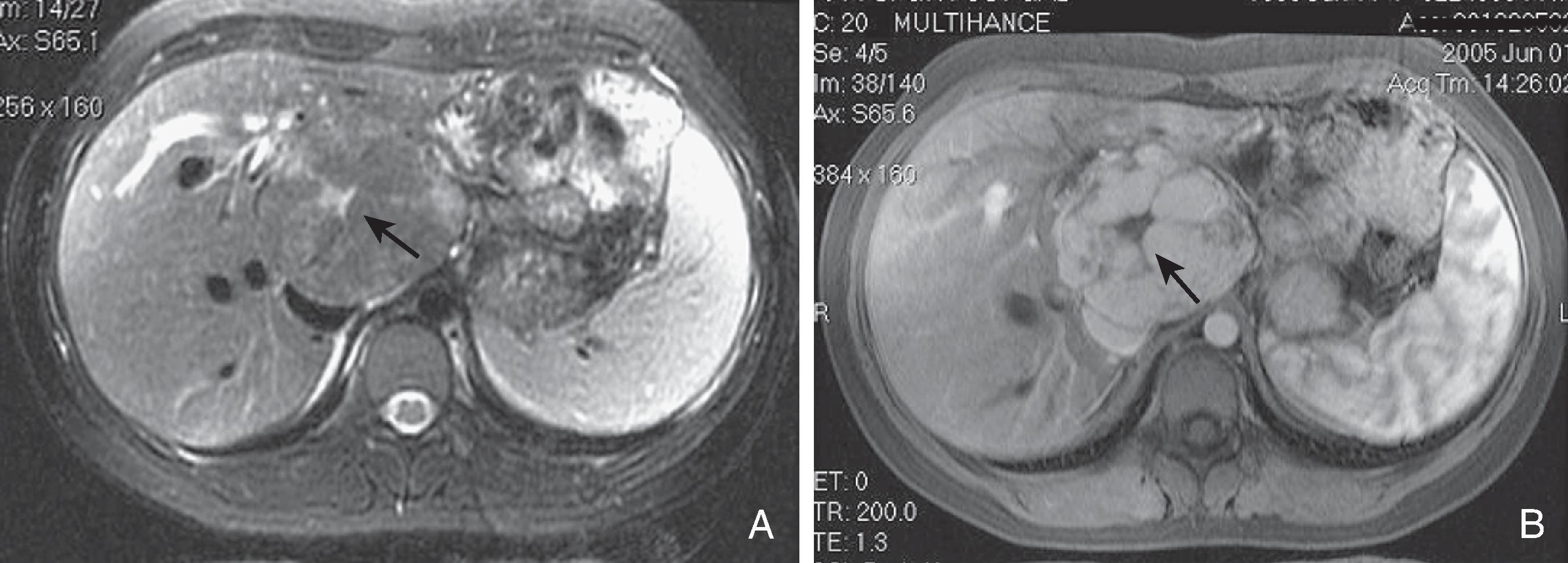
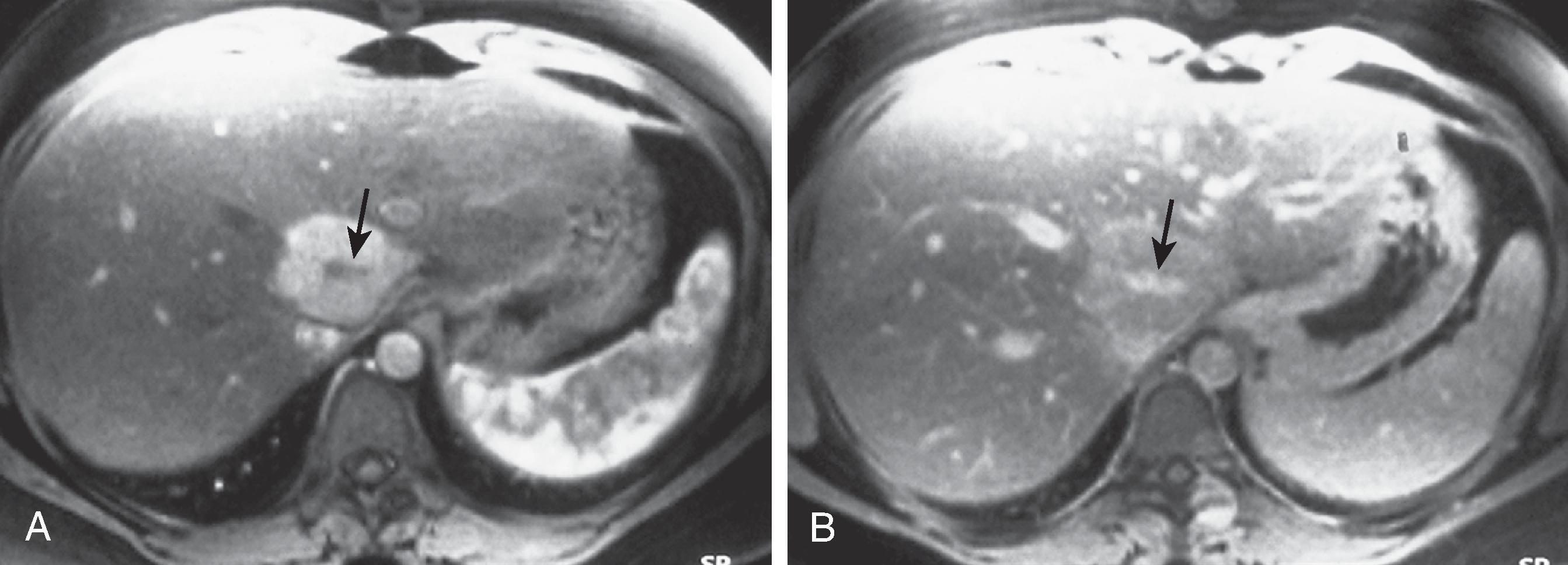
FNH, which is a hypervascular tumor, enhances robustly and homogeneously in the arterial phase, with the exception of late-enhancing central scar. Hepatocellular adenomas (HCAs) show less intense enhancement and lack a central scar.
Although other focal liver lesions, such as giant hemangiomas and hepatocellular carcinomas, may also have a central scar, MRI findings can help establish a specific diagnosis. The central scar in giant hemangiomas is typically larger and brighter on T2-weighted images. Because of the presence of scar tissue, calcifications, or necrosis, the central scar in hepatocellular carcinoma tends to show low signal intensity on T2- and T1-weighted images and typically does not enhance that much on contrast-enhanced images. Nevertheless, in some cases, FNH may show atypical features, such as very high signal intensity on T2-weighted images and a central scar with a low signal intensity that causes difficulty in differential diagnosis. In such cases, application of more sophisticated contrast media, such as superparamagnetic iron oxide particles (SPIOs), or hepatobiliary agents, such as Gd-EOB-DTPA, may be necessary to demonstrate the hepatocellular origin of the lesion.
Hepatobiliary agents can also be helpful in characterization of FNH. FNH contains hepatocytes, which take up these agents, resulting in hyperintensity of the lesion relative to the liver on T1-weighted images. , On hepatocyte phase images, FNH usually appears isointense or hyperintense relative to the surrounding liver parenchyma and shows the classic popcorn-like enhancement pattern as a result of the accumulation of Gd-EOB-DTPA and poor biliary drainage. , Similar to hemangiomas, the central scar appears hyperintense on delayed phase imaging with extracellular agents and hypointense on hepatocyte phase images with Gd-EOB-DTPA.
Hepatobiliary-specific contrast agents can be useful for differentiation of FNH from adenomas. FNH shows hyperintensity or isointensity except for a central scar in the hepatobiliary-specific phase (typically 20-minute delay for Gd-EOB-DTPA), whereas adenoma usually shows hypointensity.
FNH does not have a true tumor capsule. A pseudocapsule may be present because of compression of the adjacent liver parenchyma and surrounding inflammation. The pseudocapsule is typically a few millimeters thick and hyperintense on T2-weighted images. It may also show some enhancement on delayed postcontrast images.
Fatty change in the liver parenchyma is not uncommon in patients with FNH. The lesion may tend to show mildly low signal intensity on in-phase gradient-echo T1-weighted images and high signal intensity on out-of-phase images.
As a solid tumor, FNH shows slightly high signal intensity with increasing b values on diffusion-weighted imaging and low signal intensity on ADC mapping, with a reported ADC value between 1 and 1.40 × 10 –3 mm 2 /s. However, the ADC values cannot be relied on for lesion characterization because of the overlap with other solid lesions, including adenoma and malignant lesions. ,
HCA should be considered a spectrum of lesions that are associated with a number of diseases and etiologic factors and that demonstrate a variety of histologic appearances. Accordingly, a new classification of adenomas ( Table 53.3 ) has been proposed in which, in addition to the typical adenoma, anabolic steroid–associated HCA is described separately. This is due to its distinctive histologic appearance, which often resembles that of hepatocellular carcinoma. In addition, multiple hepatocellular adenomatosis should be considered separately from typical HCA.
| Typical hepatocellular adenoma | |
| Type I | Estrogen-associated hepatocellular adenoma |
| Type II | Spontaneous hepatocellular adenoma in women |
| Type III | Spontaneous hepatocellular adenoma in men |
| Type IV | Spontaneous hepatocellular adenoma in children |
| Type V | Metabolic disease–associated hepatocellular adenoma |
| Anabolic steroid–associated hepatocellular adenoma | |
| Multiple hepatocellular adenomas (adenomatosis) | |
Typical HCA is defined as a tumor composed of hepatocytes arranged in cords that occasionally form bile. The tumor lacks portal tracts and terminal hepatic veins; consequently, necrosis, hemorrhage, and rupture commonly occur in large tumors.
Radiologic-pathologic correlates of HCA are given in Table 53.4 .
| Pathologic Features | Radiologic Features |
|---|---|
| Rich in fat | Hyperechoic mass: ultrasound |
| Hypodense mass: CT | |
| Hyperintense mass: MR | |
| No stroma, internal hemorrhage | Anechoic, potentially cystic mass: ultrasound |
| Hyperdense area: CT | |
| Hyperintense area: T1-weighted images (MR) | |
| Avascular areas: angiography | |
| Peripheral “feeders” | Peripheral enhancement: angiography, contrast-enhanced MDCT, and MR |
| Kupffer cells | Sulfur colloid uptake (20%), SPIO uptake resulting in reduced signal on T2-weighted MR images |
| Hepatocytes, no ductules | Iminodiacetic acid uptake, no excretion |
When they are sufficiently large, HCAs can cause a right upper quadrant mass on plain radiographs. When these lesions rupture, free intraperitoneal hemorrhage can occur, producing the typical “ground-glass” appearance of free intraperitoneal fluid.
As in hemangioma and FNH, nuclear medicine is no longer routinely used in the diagnostic workup of HCA. There are also no studies reporting usefulness of PET imaging in this context. Sulfur colloid scintigraphy demonstrates a defect in 80% of cases, although tracer uptake can be present in up to 20% of tumors. Uptake is found in adenomas with a vascular supply sufficient to deliver the isotope to the prominent sinusoids.
Hepatobiliary scans show tracer uptake in the majority of cases; however, no excretion is seen on delayed scans because of lack of bile ductules. Tagged RBC scintigraphy demonstrates early uptake and a delayed defect, indicating the vascular nature of this tumor.
Become a Clinical Tree membership for Full access and enjoy Unlimited articles
If you are a member. Log in here